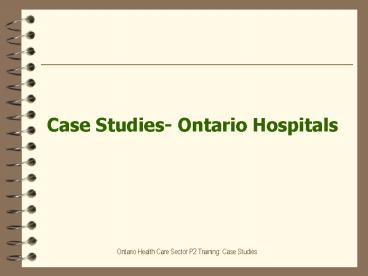Case Studies Ontario Hospitals - PowerPoint PPT Presentation
1 / 17
Title:
Case Studies Ontario Hospitals
Description:
Ontario Health Care Sector P2 Training: Case Studies. Background: -232 bed community hospital ... Care Sector P2 Training: Case Studies. Tips to Help Reduce ... – PowerPoint PPT presentation
Number of Views:52
Avg rating:3.0/5.0
Title: Case Studies Ontario Hospitals
1
Case Studies- Ontario Hospitals
2
Cambridge Memorial Hospital
- Background -232 bed community hospital
- - acute, ambulatory, LTC services
- Project Biomedical waste reduction
- Results - 1999- 21 reduction in volume of
biomedical waste from 1998 s - - 5K savings
- P2 method Improved operating practices -
Training ?Floor Awareness talks
3
Orillia Soldiers Memorial Hospital
- Background - 150 bed community hospital
- Project Improved management of halogenated
anaesthetics - Results 50 reduction in emissions to the
atmosphere of 650,000 L of nitrous oxide and
5,500 L of isoflurane vapour per year. - P2 Method Equipment Modifications
4
St. Marys General Hospital, Kitchener
- Background - 168 beds , -890 employees
- - situated in old residential area
- Project Chemical Use in Landscaping
- Zero Pesticide/ Herbicide Use on Hospital
Grounds - Results. Social benefit for patients, staff,
community - P2 Method Technological modification
5
London Health Science-Pathology Dept
- Project On-site Solvent Recycling
- Results ? purchases of xylene ethanol
- - environmental benefit
- ethanol not discharged to sewer
- xylene not incinerated
- - 22.5 month payback on units
- P2 method Improved operating practices-
management practices
6
Hamilton Health Sciences Corp.
- Background - 4 hospitals -1160 beds
- - 8000 employees
- - largest provider of
comprehensive health services in Ont - Project - Energy Management Action Plan
7
Hamilton Health Sciences Corp.
- Results
P2 Method Equipment Modifications
8
Strong Memorial HospitalMercury Thermometer Use
Reduction
9
NON-MERCURYTEMPERATURE DEVICES
10
Other Mercury Reduction Activities
- Replace all mercury filled sphygmomanometers
- Use tungsten-filled GI tubing
- Replace all mercury in special stains lab
- Use low mercury fluorescent lamps
- Install energy efficient lighting
- Improve dental amalgam collection
11
Tungsten-filled GI Tubing
12
PVC Plastic
- Value Analysis Committee has not been satisfied
with current choices alternatives for some
products such as IV bags. - Supply companies have been asked about PVC-free
products and seem responsive - Emphasis on supply side will drive changes
- Even so, there are ways to reduce PVC use
13
Reduction Through Re-use
- FDA approval for third party re-certification for
single use items effective date 8/200 - Multiple uses for formerly single use items
- Suppliers will sell back at 1/2 price.
- Will save about 300,000/ yr
- Exploring reusable sharps shelters. This may
save 50,000 lbs. of plastic per year
14
Chemical Reduction in Landscaping Practices
15
Eliminating Chemical Use
- Meet with your current landscaping company
- Determine if the company has the ability and or
willingness to eliminate chemical use. - Discuss 1current chemical use, 2available
environmental alternatives, 3commitment to
reduction and/or elimination, 4costs, 5timelines,
6infestations/disease prone areas. - Research other landscaping companies if current
company is unwilling to eliminate chemical use.
16
Eliminating Chemical Use
- Ensure resources are allocated by Senior
Management to begin. - Educate staff about changes to the
grounds-keeping practices (i.e. the grass may not
be as green as it was before.) - Set 5-year plan (dont do it all at once- )
- Utilize student resources in the development of
your landscape, if possible. - Keep lawn watered!
17
Tips to Help Reduce Chemical Use
- Plants, trees, shrubs prone to pest infestations
or disease should be promptly removed (when
possible). - Re-seeding, aerating, fertilizing, and regular
watering of lawn areas helps with keeping lawn
healthy. - Alter the landscape so that it doesnt need
intervention - Use native plants/shrubs, drought resistant
plants, shade tolerant plants, salt-tolerant
plants, groundcovers































